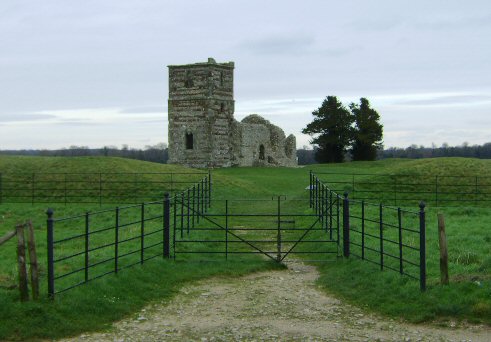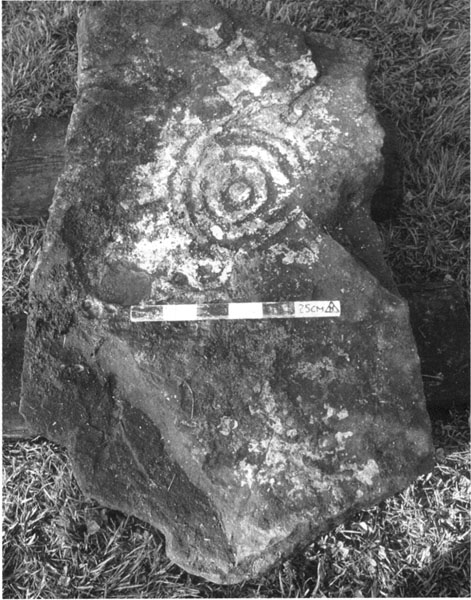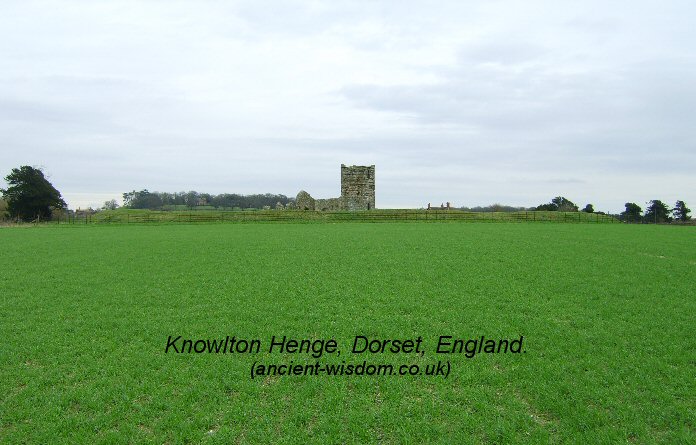|
Location:
Cranborne, Dorset,
England.
(SU02450994). |
Grid Reference:
50� 53' 30" N, 1� 57' 57" W. |

 Knowlton:
(Henge).
Knowlton:
(Henge).
Although the henge at Knowlton appears to
be a fairly small construction, it is in fact one of the last surviving
parts of a much larger prehistoric complex.
One of the most important
complexes in Wessex.
The remaining henge
was Christianised in the 12th century with the construction of the Norman
Church in the centre of the central henge.
(Click here for Map of
site)
('Knowlton Circles', ''Knowlton
Rings', 'Church Circle', 'Church Henge')
The group
of Late Neolithic henge monuments at Knowlton is generally
recognised as one of the five most important enclosure complexes
in Wessex at this time (Renfrew 1973; Wainwright 1989).
The Heritage
plaque at the site says that the henge was constructed c. 2,500 B.C, consisting of a
ring bank with two entrances and an internal ditch, 'probably intended for
ceremonial use'. It is now realised that the Knowlton henge was only a
single part of a larger 'sacred' prehistoric landscape, which was re-used
for thousands of years, ending with the construction of the Norman church in
the middle of the central henge in the 12th century AD.
'Knowlton Rings' consists of 4
earthworks: the North Circle, Church Circle, Southern Circle, and the 'Old
Churchyard'. In addition to these sites, to the east of the Church Circle is
the Great Barrow, the largest round barrow in Dorset, and almost certainly
directly related to the henges. (1)
The most prominent site in the complex is the 'Church Circle',
now commonly called Knowlton Henge.
(Not far to the west of Knowlton is
the Dorset Cursus, running for over 6
miles in length).
Article: Bournemouth
Daily Echo, 10th June 2005.
'An ancient standing
stone from a lost stone circle has been unearthed by dowsers in east Dorset.
Students on a local dowsing course discovered the hidden Bronze Age relic at
Knowlton Henge, two miles south of Cranborne. Experts are calling it one of
the most exciting finds in the region for years. And, intriguingly, the
dowsers pinpointed the ancient flat stone after spotting an energy line on a
photo of the area.
"It's a very
significant find," said Paul Craddock, chairman of Wessex Dowsers and a
local dowsing tutor. "Where the stone was discovered, we believe there may
have an avenue of stones. We also think there is a second stone close by,
buried upright in the ground".
The large slab is
thought to have been part of a stone circle which was widely believed to
have been either knocked down or broken up when the 12th century Norman
Knowlton Church was built on the same spot'. It is suggested that other
stones may have been used in the church's foundations, and to form part of
the altar.
|
Article: Concentric stone
found in Knowlton southern Henge.

During the Spring 2000 season of the
Wyke Down project (see French et al.) an exciting
archaeological discovery was made. Two large stones were ploughed
out of the southern henge at Knowlton, Dorset c. 30 years ago were
located on a farm (Knowle Hill Farm, part of the Shaftesbury
Estate). It was suggested that the stones came from the bank of the
south-eastern section of the henge (Fig. 1), and that one stone had
artwork on it.
The two
stones were found and examined. They appear to be heathstone, an
iron-rich sarsen stone, which is found locally at the edge of tertiary
deposits, but this is yet to be confirmed.
The first stone found is rectangular, roughly 60 cm
wide, 105 cm long and 18 cm thick, and has a design of four
concentric rings pecked into its centre on one side (Fig. 2). The
design is reminiscent of patterns of concentric circles found on
Grooved Ware pottery from Down Farm, c. 4 km upstream. This appears
to be a fairly rare motif for Grooved Ware, but has been found on at
least 4 vessels, one from Henge I at Wyke Down I, and three from two
postholes and a pit outside of the henge at the Wyke Down II site at
Down Farm (Green 1987; Cleal 1991, 1999). (2)
(Click here for full article) |
Gallery of Images: Knowlton.

The Henge and Church from outside.

Looking across from the Southern entrance to the Northern entrance.

A large prostrate stone in the ground within the Knowlton henge.
(More
about Henges)
(Other Prehistoric English sites)
|